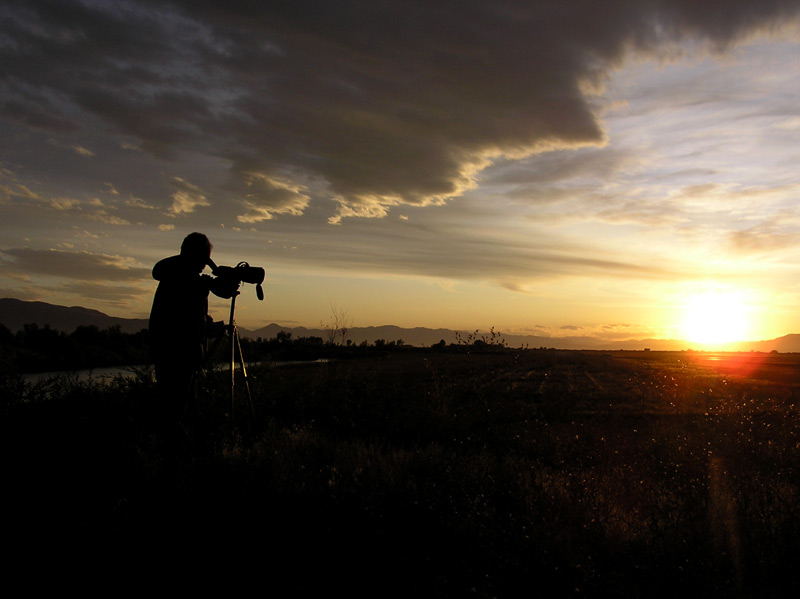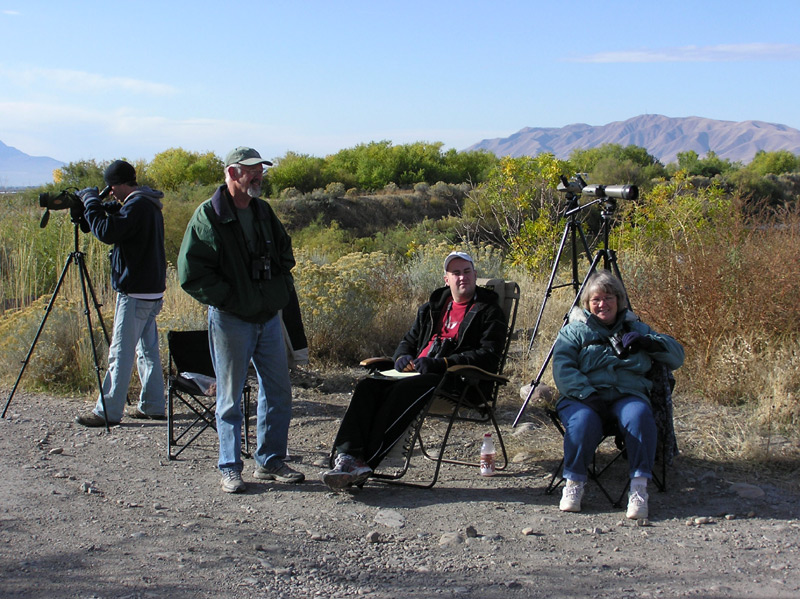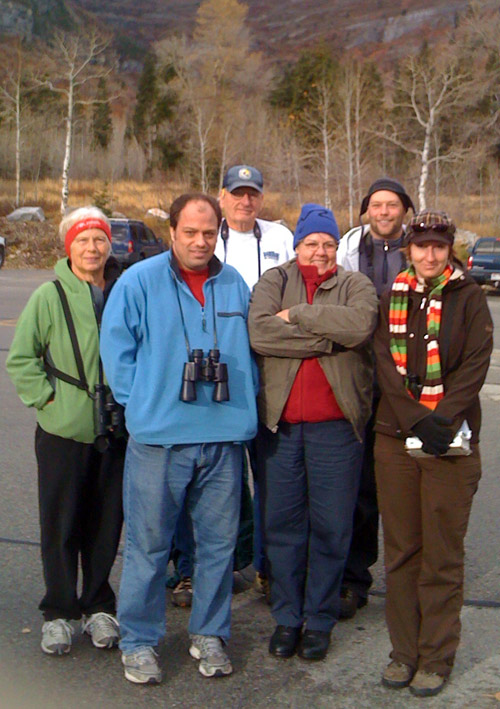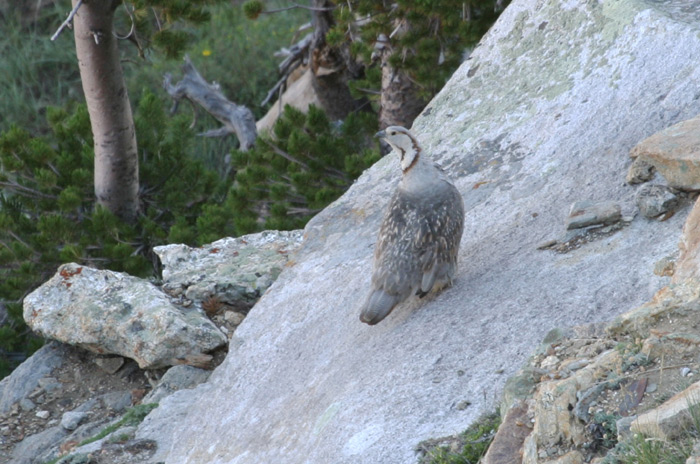Utah County Birders Newsletter
|
 |
Contents
November Meeting
Upcoming Field Trips
Ned's Notes
Field Trip Report - The Big Sit
Field Trip Report - Provo Canyon, Aspen
Grove
Bird of the Month
Backyard Bird of the Month
NOVEMBER MEETING:
Thursday, November 12th.
Merrill Webb - “Birds
of Panama"
Meet at 7:00 PM in the Bean Museum Auditorium on the BYU Campus.
November 14 (Sat), 2009: Loon Loop
- 7:00 a.m.-12 p.m., meet at Sam’s Club parking lot, 1313 S. University Ave.,
Provo: Deer Creek and Jordanelle reservoirs, East
canyon reservoir, and the Antelope Island Causeway if time and the
birds permit.
December 19 (Sat) 2009: Provo Christmas Bird Count
- Please mark you calendars. This year's Provo Christmas Bird Count will take
place on Saturday, December 19th. We will gather to report our findings that
evening at 6:00 pm. We'll let you know where as the time approaches. Contact Ned
Hill if you are interested in participating.
We are actively recruiting people to lead local half-day field
trips, any time, any place. If you would like to lead a field trip or if you
have any ideas for this year’s field trips, please contact Lu Giddings at -
seldom74@xmission.com.
Ned’s Notes
Confessions of a Birder Spouse
Part II
Delusions and Insanity
by Claralyn M. Hill
Before I expound on my worldwide adventures with my birder boy husband, I must
tell you that I am neither delusional nor hallucinogenic, as my family has
thought from time to time. This appearance of delusion results from the many
true encounters I’ve had with Ned’s bird buddies, even in our house, and the
assumptions that have been created by these close calls, some of which I
described in the last newsletter. So, I confess my ignorance, confusion, and
exuberance over birds have led me to this state of vulnerability in which my
family must watch over me; but after you have read this I’m sure you’ll agree
that my family has some responsibility for my apparent delusions as well!
My first brush with insanity took place over twenty years ago in Venezuela. Ned
and I had gone there for meetings and a little R&R. We stayed in a lovely little
ancient hotel in Caracas. A caged toucan outside the building enhanced the South
American atmosphere. Of course, however colorful and lively the toucan was, he
didn’t “count,” as he was caged. So we spent every moment we could away from the
pool and the meetings searching for birds. The most ubiquitous bird around the
hotel was a small bird that seemed active early in the morning about the time we
were waking. He had a high pitched “meep, meep” call, and was always up before
us, no matter how early we arose. I was never able to see him, though I searched
around the hotel grounds while Ned was in meetings. Apparently, he quieted down
by the time I got outside. But I appreciated his early morning cheerful company
so far from home. Years later, when I traveled again with Ned, this time to
Boston, I heard my little friend again. “How could he be in Boston?” I asked
Ned. Could it be that he was migratory and happened to have been in both
locations just at the times we traveled there? No, my expert husband observed
dryly. My little bird was just his travel alarm.
The second experience happened only a few years ago. One night, when all the
children and grandchildren had left for the evening, and Ned was traveling
worldwide, I went into the kitchen to finish cleaning up. I was alone in the
house, but I heard a distinct sound of a bird singing. In fact, as I listened,
the bird song took on the sound of Brahms lullaby. How strange! Could a bird
really sing to the tune of “lullaby and good night, la de da da--de da da?” But
there it was. I heard it again. Maybe a mockingbird was outside. I knew that
magpies and flickers had made their nests in the eves and crevices of the house
that year, right under the kitchen window, and I conjectured that some mama bird
had learned to copy that tune and was singing it to her baby birdies. I felt a
kinship. I had sung to my babies, too. I tried to seek out where the sound was
coming from. It was coming from under the kitchen sink. There—it must be the
birds in the crevice below. Still, it was eerie.
I called our daughter, Alison, and explained that a bird was singing Brahms
lullaby in the eaves of the house somewhere. “Can they really do that?” I asked.
Alison is her father’s daughter, and I rely on her to answer such questions when
he is out of town. She was clearly alarmed and asked me to stay on the phone
with her while she jumped in the car to come right over. “Someone must be in the
house with you,” she fretted. No, I could tell this was not a person. Alarmed,
she drove closer, still on the phone. The tone in her voice changed to that of a
person set to have her mother straitjacketed. She asked me to keep trying to
figure out what it really was. She obviously did not believe in Brahms-singing
birds. I continued to search for the source of the sound. It was not exactly
under the sink. More to the right. As we talked, I pulled out the drawer
reserved for children’s toys. There, in the drawer to the right of the sink, was
a little electronic singing toy one of the children had dropped in before
leaving. Its tone was curiously like that of the Venezuelan bird I had heard
years before, only this one could sing. I told Alison what I had found and she
returned to her family, relieved that she had not had to rescue me.
Now, I don’t want to blame anyone but myself for these fiascoes, and I continue
to maintain that my mind is sound. But I would also like to propose that those
of us who live with birder boys may have to fight off insanity more than the
average person!
 |
|
Oliver watching Redheads in the moat at sunset on the
Big Sit |
 |
|
Matt, Milt, KC and Tuula at The Big Sit |
The Big Sit - 11 October 2009
By Eric Huish
The Utah Lake Provo Airport Dike Sit Circle was covered from 6:10 a.m. to 12:30
p.m. and again from 5:00 p.m. to 7:30 p.m. This was our 8th year participating
on the big sit. Matt Mills and I got there just after 6:00 a.m. and KC Childs
showed up shortly after. A barn owl was the only bird we got in the dark that we
never saw again during daylight hours.
Showing up at a more sensible time were Tuula Rose, Milton Moody, Yvonne Carter,
Keeli Marvel, a couple of nice folks I hadn't meet before now (I forgot your
names). Tuula's Daughter and Grandson also joined us for a while. We all left
for lunch at 12:30.
At 5:00 p.m. I retuned to the circle. Oliver Hanson had birded the dike and was
looking for the Big Sitters when I got there. Ned Bixler joined us a little
later and we birded to after sunset. A beautiful sunset.
We didn't have the mudflats we've had in past years so our shorebird list was
low but we got a higher than average duck list.
It can be maddening the birds you miss on a big sit. Just 3 days before the sit
I saw cormorants from that spot, the afternoon before the sit KC and I had
Sandhill Cranes out there and the day of the sit Matt saw a Junco in the brush
just 20 yards away but he wasn't in the circle and no one was able to see it
from the circle. Just to name a few examples of misses.
We were able to see or hear 54 species from our circle. Our record is 58 species
in one day and our 8 year (8 day) Big Sit Life List is now at 105 species. We
added one Big Sit Lifer this year - Eurasian Collared-Dove.
Here is our list. Number of species: 54
Canada Goose 15, Gadwall 1, American Wigeon 2, Mallard 4, Northern Shoveler 4,
Northern Pintail 1, Redhead 2, Ruddy Duck 1, Ring-necked Pheasant 3, Pied-billed
Grebe 5, Western Grebe 1 (Heard Only), Great Blue Heron 2
Snowy Egret 1, Black-crowned Night-Heron 1, White-faced Ibis 2, Northern Harrier
1, Sharp-shinned Hawk 1, Red-tailed Hawk 1, American Kestrel 2, Merlin 1,
Virginia Rail 1 (Heard Only), American Coot 2, Killdeer 5, Greater Yellowlegs 1
(Heard Only), Wilson's Snipe 2, Ring-billed Gull 20, California Gull 3, Rock
Pigeon 6, Eurasian Collared-Dove 30, Barn Owl 1, Belted Kingfisher 2, Downy
Woodpecker 1 (Heard Only), Northern Flicker 2, Black-billed Magpie 1, Northern
Rough-winged Swallow 20, Barn Swallow 150, Black-capped Chickadee 2, Marsh Wren
3 (Heard Only), Blue-gray Gnatcatcher 1, American Robin 200, European Starling
300, American Pipit 3, Cedar Waxwing 4, Orange-crowned Warbler 1, Yellow-rumped
Warbler 5, Spotted Towhee 1, Song Sparrow 1, White-crowned Sparrow 3, Red-winged
Blackbird 50, Yellow-headed Blackbird 1, Western Meadowlark 1, Brewer's
Blackbird 10, House Finch 8 and American Goldfinch 2
 |
|
Left to right - Junece, Oliver, Ned, Karen, Eric and
Keeli. |
Provo Canyon and Aspen Grove -
24 October 2009
By Lu Giddings
October field trips can be a bit tricky, trying to avoid duck hunters in the
wetlands, deer hunters in the mountains, and hoping all the while the weather
and the birds cooperate. Seven Utah County birders made stops in Provo Canyon at
Canyon Glen Park, Vivian Park, and Aspen Grove this morning. In spite of a bit
of rain and a rather cool breeze, the time was well spent. We viewed several
winter wrens along the bicycle path through Canyon Glen Park. We counted at
least two but there were probably several more. We may have heard yet another
winter wren during a brief stay at Vivian Park but the road noise made it very
difficult to be certain. We wondered whether these were winter arrivals, or
possibly birds that are summer residents that either remain unnoticed during
summer or perhaps migrate further up the mountain when it’s warm. We also
enjoyed excellent looks at a golden-crowned kinglet while at Aspen Grove and a
golden eagle soaring overhead.
Participants: Ned Bixler, Lu Giddings, Karen Hansen, Oliver Hansen, Eric Huish,
Junece Markham and Keeli Marvel.
A partial trip list: species: 16
Golden Eagle, Belted Kingfisher, Northern Flicker, Steller's Jay, Western
Scrub-Jay, Black-billed Magpie, Common Raven, Black-capped Chickadee Mountain
Chickadee, Brown Creeper, Winter Wren, American Dipper, Golden-crowned Kinglet,
Ruby-crowned Kinglet, Yellow-rumped Warbler and Song Sparrow.
 |
|
photo by Bryan Shirley |
Bird of the Month
Himalayan Snowcock
(Tetraogallus himalayensis)
by Grant Jense
There are five subspecies of Himalayan Snowcock that belong to the order
Galliformes and the family Phasianidae. Males average 28 inches in length and
stand about 14 inches high. Game farm raised hens average 4.3 pounds and males
5.5 pounds. One large male killed by a hunter weighed 10 pounds.
Snowcock resemble a large chucker at a distance. They are large and the plumage
is patterned with grey, brown, white and black, but look grey at a distance. The
face and throat are white with a brown band below the eye that extends onto the
neck forming a collar. Females are similar to males, but lack tarsal spurs and
have more buff on the face.
The nest is a scrape on bare ground and typically contains 5-10 eggs. Only the
female incubates the eggs, but both parents raise the young. Snowcock eat seeds
and vegetable matter such as grasses, sedges and forbs. They occupy high
elevation alpine and subalpine habitats that have open areas near rocky,
precipitous hillsides with cliffs and edges. On native ranges they summer at
elevations near 17,000 feet and spend the winters as low as 7000 feet, depending
on the amount of snowfall.
The Himalayan Snowcock is native to Central Asia from central and northern
Afghanistan east through Pakistan, northwestern India to Nepal and parts of
Tajikistan, Kyrgyzstan, Kazakhstan and China.
In 1961 a Nevada sheep hunter, Hamilton McCaughey, noted the habitat
similarities between some Nevada mountains and India. He made arrangements with
the President of Pakistan to obtain snowcock. The first shipment was received in
1963, but suffered 63% loss while in transit. By 1965 Nevada received a total of
107 snowcock from Hunza, Pakistan. Due to heavy losses during transportation the
Nevada Department of Wildlife decided to attempt to raise snowcock on a game
farm in Mason Valley. From 1965-1979 2,025 snowcock were propagated and released
into the wild. They found that propagating snowcock was difficult and their
optimistic goal of 1,200 - 1,400 annually was not met.
Snowcock were released into five Nevada ranges. The major release efforts were
centered in the Ruby and East Humboldt Mountains of Northeastern Nevada. A total
of 1,717 snowcock (17 wild and 1,700 game farm raised birds) were released into
the Ruby Mountains, which contains the majority of snowcock habitat in Nevada,
about 30 square miles. Snowcock have only established viable populations in the
Ruby and East Humboldt ranges. Places where snowcock have been observed in the
Ruby Mountains include Thomas Peak, Wines Peak, Ruby Dome, Mount Gilbert, Verdi
Peak and Old Man on the Mountain. Most of these peaks are over 11,000 feet.
Several winter/spring observations have been across from Camp Lamoille near
8,000 foot elevation in Lamoille Canyon. Probably the majority of sightings have
been in the Island Lake and Thomas Peak area. A good trail that is two miles in
length leads to Island Lake. Snowcock have been observed on the slopes above the
lake and on the nearby slopes of Thomas Peak.
Snowcock usually fly down from their roosts on ridge tops at dawn into open
areas containing vegetation to feed. They then walk back up the mountain to
their roost sites.
When searching for snowcock it is helpful to know their calls, since they are
often heard before they are seen. They are often seen flying from roost sites to
feeding areas, but generally walk away from where they land. They often perch on
high ledges and rock pillars found in the middle of some chutes. These areas
provide great vantage points and a very easy means of escape. Snowcock tend to
be very jumpy and easy to flush. A good time to search for snowcock is in late
July and August when broods have a tendency to form small coveys. (continued on
next page)
The Island Lake / Thomas Peak area is a very beautiful place to be at sunrise on
a clear summer morning and seeing snowcock in such a pretty area is a very
rewarding experience as experienced by Dennis Shirley, Alton Thygerson and Grant
Jense on August 28, 2009.
October 2009
Eric Huish - Pleasant Grove
A pair of Common Ravens spent a few minutes circling over the yard. I
don't often get ravens here.
Bonnie Williams – Mapleton
I had a Rufous Hummingbird in my yard that was last seen on October 15.
Steve Carr - Holladay
All 3 Carduelins are back at the Nyjer feeders.
Alton Thygerson -- Provo
Two Black-capped Chickadees making their quick visits to a feeder
Milt Moody – Provo
Ruby-crowned Kinglet doing its butterfly imitation
Reed Stone - Provo
About 30 CEDAR WAXWINGS stripping berries from Mt. Ash tree. WONDERFUL!
KC Childs – Provo
I just recently moved into a new house in Provo, so things are slow to get
going. The best bird thus far is a Cedar Waxwing.
Yvonne Carter – Highland
Returning home from Cape May, NJ I have Juncos and a Northern Flicker.
It's a little quiet since the feeders were neglected while I was back East.
Alona Huffaker - Springville
There's very little good to be said about the return of "old man winter". except
it also brings back our winter bird friends! This week I've had Oregon Juncos,
Western Scrub Jays, Mountain Chickadee, and I heard a Spotted
Towhee.
We would like you to share your favorite backyard bird each
month. Please send your favorite bird at the end of the month to
newsletter@utahbirds.org or call
Cheryl Peterson at 375-1914 (home) or 787-6492 (cell).
We are accepting
2009 dues for membership in Utah County Birders throughout the 2009 season. If
you would like to be an official member of our group and receive a handheld copy
of the newsletter, do the following:
Make a check out to Utah County Birders for $15.00.
Put it in an envelope addressed to:
Carol Nelson
2831 Marrcrest West
Provo, Utah 84604
Then, drop it in the mail. And as always, thanks for your support and a special
thanks to those we never see, but who still show their support by their dues
donations!